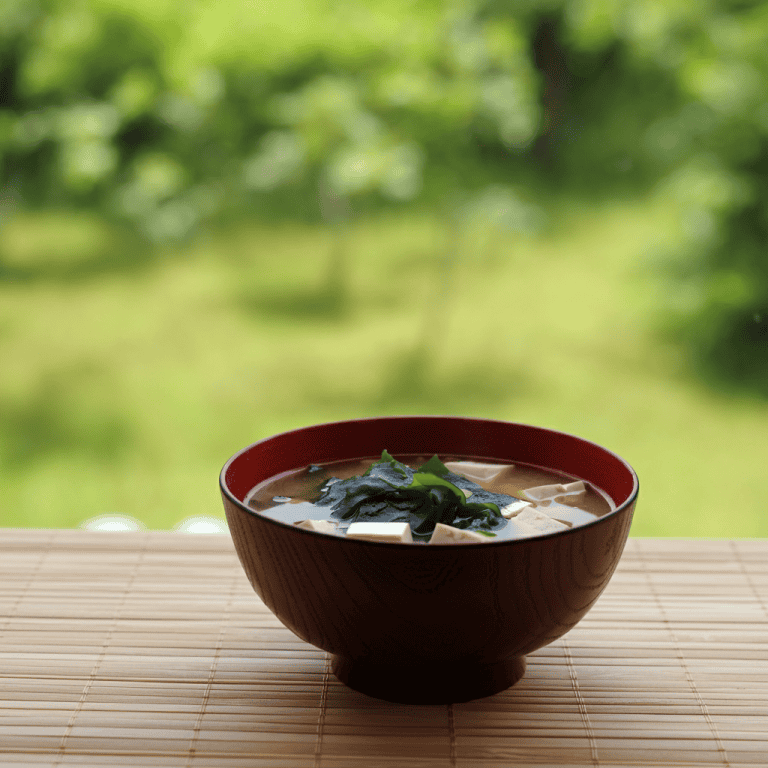Dashi-Free Miso Soup Recipes for Easy Cooking
Revolutionize your kitchen with some amazingly easy miso soup recipes without dashi, offering the classic flavor that comforts like no other. Whether you’re seeking a healthy meal alternative or simply yearning for a bowl of warmth, these miso soup variations allow anyone to whip up a quick and nutritious dish. Say goodbye to complex preparations and embrace the simplicity that makes miso soup a timeless Japanese culinary treasure.
Key Takeaways
- Discover how to create classic miso soup flavors without the need for dashi stock.
- Learn easy cooking techniques for a comforting bowl of miso soup.
- Explore healthy meal options with versatile ingredients in miso soup.
- Understand the benefits of utilizing readily available substitutes like vegetable broth and kale.
- Gain insight into the importance of miso paste as the quintessential ingredient in achieving the unique taste of miso soup.
What is Dashi?
In English-speaking countries, Dashi is often referred to as livestock or seafood-based broth.
But
That is NOT true!!
Here are the real meaning of Dashi;
Dashi is a fundamental ingredient in Japanese cuisine, serving as the base for many soups, broths, and sauces. It is a simple yet flavorful stock typically made from just a few key ingredients.
The most common types of dashi are:
- Katsuo Dashi (Bonito Dashi): Prepared by simmering dried bonito fish flakes (katsuobushi) in water. It has a stronger, fishy flavor and is often used in miso soup and noodle broths.
- Iriko or Niboshi Dashi: Made from dried small sardines or anchovies, this dashi has a robust and slightly fishy flavor, commonly used in soups and stews.
- Kombu Dashi: This is a vegetarian version made by simmering kombu, a type of edible kelp. It imparts a mild, savory flavor with a distinctive umami taste.
- Shiitake Dashi: A vegetarian dashi made by soaking dried shiitake mushrooms. It has a rich, earthy flavor and is often used in vegetarian dishes.
I listed four major dashi types, but can be made from any ingredients. #1 and #2 are fish-based broth but #3 and #4 are completely vegetable-based dashi.
Dashi is valued for its ability to enhance the flavors of other ingredients without overpowering them. The umami richness it brings is a cornerstone of the subtle yet complex flavors characteristic of Japanese cuisine.
Before reading the content below
The following content discusses “Dashi-Free,” but it actually refers to vegan-friendly dashi/stock. Please bear this in mind while reading.
An Introduction to Dashi-Free Miso Soup
Steaming bowls of miso soup have served as the backbone of Japanese cuisine for generations, symbolizing comfort in its most traditional form. Yet, not all soups are created equal, and for many modern cooks or vegetarians, the quintessential ingredient, dashi, presents a challenge—whether due to availability or dietary preferences. Thankfully, miso soup’s versatility shines through in its dashi-free variants, which leverage vegetable broth to capture the soul-soothing essence of this traditional Japanese soup without compromising on flavor.
Opting for miso soup no dashi doesn’t mean skimping on taste or authenticity. On the contrary, it opens a world of culinary creativity while staying true to the dish’s comforting nature. The robust flavor comes from finding just the right balance of umami—using rich, quality miso paste and substituting the oceanic undertones of dashi with a hearty vegetable broth, yielding a dish every bit as enriching as the original.
The recipe for miso soup without dashi calls for simple, whole food ingredients and follows an equally unfussy process—making it a perfect candidate for a quick lunch or a starter for a larger meal. Greens like kale take the place of seaweed, simulating the necessary complexity and providing textural contrast. At the center lies the miso paste—fermented, flavorful, and flexible in its application—ensuring each sip carries the depth expected from this traditional staple.
- Miso paste remains the star, offering rich umami flavors.
- Vegetable broth acts as a robust base, welcoming all to enjoy regardless of dietary choices.
- Adding freshness and crunch, green onions alongside kale enrich the broth.
- Firm tofu incorporates gently into the mix, introducing protein and satiety without overpowering the delicate balance.
While the journey of making miso soup no dashi may stray slightly from the paths walked by generations before, the destination—a warm, inviting bowl of miso soup—remains delightfully the same. This accessible adaptation invites you to enjoy a slice of Japanese culinary heritage, right from the comfort of your own kitchen.
Miso Soup Recipes Without Dashi: Your Ultimate Guide
Embarking on the journey of creating your own miso soup minus the traditional dashi might seem daunting at first. However, with this guide, you will learn that a satisfying bowl of miso soup is easily within reach using substitutes such as vegetable broth and various condiments. This adaptation not only simplifies the process but also offers an opportunity to customize the soup according to your taste preferences.
Understanding the Basic Components of Miso Soup
Miso soup is acclaimed for its signature depth and comforting umami character. The bedrock of this flavor profile is the miso paste, a fermented marvel that brings complexity to even the simplest of broths. Although the classic recipe includes dashi, a miso soup dashi substitute made from chicken or vegetable broth can also cultivate a robust base for the soup, ensuring no flavor is sacrificed in the absence of dashi.
Versatility of Miso Paste in Various Cuisines
Miso paste’s dynamic nature allows it to transcend boundaries, influencing an array of global cuisines. In the absence of dashi, miso paste continues to impart its characteristic taste across vegetarian, pescatarian, and carnivorous diets alike. Whether you’re mixing it into a salad dressing or a marinade, miso paste consistently adds richness and depth, securing its status as a truly versatile ingredient in the culinary world.
Benefits of Using Vegetable Broth
Opting for vegetable broth as the base for your miso soup enriches the dish with not only a warmth but also a wholesomeness that’s hard to rival. It paves the way for a vegetarian-friendly version of the soup, while maintaining the full-bodied flavor profile typically brought about by dashi. The result is a nourishing and savory broth that brings comfort in each spoonful, suitable for an array of dietary requirements and preferences.

As we explore these pillars of delicious miso soup without dashi, it’s clear that miso paste is not just an ingredient but a catalyst for creativity in the kitchen. It provides an opportunity to craft a warm, miso-infused experience with each meal, irrespective of having dashi at hand. Thus, the spirit of Japanese culinary artistry lives on through every adaptation and interpretation of miso soup we create.
Ingredients for a Flavorful Dashi Substitute
Preparing a healthy comfort food like miso soup starts with selecting the right miso soup ingredients. While traditional recipes call for dashi, a fish-based stock, those seeking a dashi substitute can create a delicious alternative with vegetarian-friendly components. A miso soup brimming with nourishment and umami can easily be achieved with a few simple substitutions.

The base of any great miso soup is its liquid component. In lieu of dashi, a homemade vegetable broth can be used. Not only does this serve as a dashi substitute, but it also adds a layer of flavor complexity while keeping the dish plant-based and accessible to those on a vegetarian or vegan diet.
| Ingredient | Role in Soup | Health Benefit |
|---|---|---|
| Vegetable Broth | Substitute for dashi; provides a savory foundation | Rich in nutrients and suitable for many diets |
| Miso Paste | Essential flavor profile; adds richness and depth | Contains probiotics for gut health |
| Green Onions | Adds a mild, crisp bite; garnish for freshness | Source of essential vitamins and antioxidants |
| Kale | Textural substitute for seaweed; creates complexity | Loaded with fiber, vitamins, and minerals |
| Firm Tofu | Adds substance and protein | Provides a plant-based protein source |
Integral to the soul of the dish is miso paste, packed with fermented flavor that is the hallmark of classic miso soup. For those seeking a dashi substitute, combining miso paste with healthful additions like thinly sliced green onions and richly flavored kale, which stands in for kombu seaweed, preserves the traditional essence. Firm tofu brings the bowl to a satisfying conclusion, providing a healthy punch of protein and texture to complement the delicate soup base.
By using these carefully chosen ingredients, home cooks can easily assemble a comforting bowl of miso soup that taps into the essence of Japanese culinary practice, without straying from dietary preferences or convenience. This gastronomic alchemy not only offers a deep, satisfying flavor but also embodies the heartiness of healthy comfort food, perfect for nourishing both body and soul.
Step-by-Step Cooking Instructions for Miso Soup without Seaweed
Embark on crafting a heartwarming miso soup recipe without dashi with these simplified steps. This version is perfect for those looking for a comforting bowl of miso soup without seaweed. It’s an ideal go-to recipe for both novice cooks and seasoned chefs alike.

Begin this culinary adventure by heating your vegetable broth in a pot over medium-high heat. Once it reaches a simmer, you’re ready for the next step.
- Pour 4 cups of vegetable broth into a pot and turn the heat to medium-high to bring it to a boil.
- Reduce the heat to low, allowing the broth to simmer gently.
- Add 3 thinly sliced green onions and 2 cups of thinly chopped kale to the pot, cooking for approximately 5 minutes to infuse the broth with their fresh flavors.
- Introduce 2 cups of diced firm tofu into the mixture and continue simmering for another 5 minutes, letting the tofu absorb the broth’s savory essence.
- Remove the pot from the heat. In a separate bowl, blend 3 tablespoons of miso paste with a ladle of the soup (about 1/2 cup) and whisk until smoothly dissolved.
- Stir the dissolved miso mixture back into the soup pot, ensuring an even distribution for a velvety finish.
Pro tip: Always remove the soup from heat before adding miso paste to prevent it from boiling. This ensures that the miso stays smooth and retains its beneficial properties.
| Ingredient | Portion | Action |
|---|---|---|
| Vegetable Broth | 4 cups | Boil and simmer |
| Green Onions | 3 | Slice thinly and add to broth |
| Kale | 2 cups | Chop thinly and cook in broth |
| Firm Tofu | 2 cups | Dice and simmer in broth |
| Miso Paste | 3 tablespoons | Blend with a portion of soup and stir in |
By following these steps, you will have mastered a delicious miso soup recipe without dashi that resonates with the same depth and nourishment as the traditional Japanese version. It’s a testament to the adaptability of this beloved dish and its capacity to continue to provide solace and satisfaction, no matter the variation.
Expert Tips for a Perfect Bowl of Miso Soup
Perfecting the art of miso soup, especially when preparing miso soup recipes without dashi, starts with understanding the nuances of miso paste and how best to utilize it in your cooking. Below, discover some expert tips that not only enhance the taste but also maximize the longevity and versatility of miso paste in various culinary applications.
Where to Find Miso Paste in Your Local Store
Locating miso paste might require a bit of a scavenger hunt, but the quest is well worth it. Start by checking the refrigerated section of your local grocery stores where fresh condiments and international ingredients are stocked. It’s not uncommon for miso paste to be placed alongside other chilled Asian condiments. If you can’t find it there, ask a store employee—it might be stored in bulk away from the public aisles. At times, miso paste may also be available on the regular shelves, so browse the international food aisle thoroughly to locate this flavorful gem.
Storing Miso Paste for Longevity
The proper miso paste storage is vital for maintaining its quality and extending its shelf life. Once purchased, miso paste should be stored in the back part of your refrigerator, where the temperature tends to be coldest and most consistent. Keep it in its original packaging or transfer it to an airtight container to prevent it from drying out or absorbing other food odors. With this method, miso paste can last for several months, remaining as potent and delicious as the day you bought it.
Using Miso Paste Beyond Soup
While miso paste is the cornerstone of many miso soup recipes without dashi, its utility goes far beyond soups. This versatile ingredient can infuse salads and proteins with layers of deep, savory flavor. Try whisking miso paste into a dressing with a bit of olive oil and lemon juice for a unique salad dressing. Alternatively, marinate chicken, fish, or vegetables with a miso-based concoction before grilling or roasting to introduce an umami-packed twist to your favorite dishes. One particularly popular combination is using miso paste on broiled salmon—its robust flavor beautifully complements the richness of the fish.
Remember, when preparing your miso soup, never boil the miso paste. Adding boiled liquid to the miso or introducing it to a bubbling pot can result in a grainy texture and diminished flavor. Instead, remove your soup from the heat before you whisk in the miso—an essential step for that perfect bowl of soup.
Miso paste uses extend well beyond traditional applications. By incorporating it into a variety of dishes, you’re not only enriching flavor profiles with its distinct taste but also adding nutritional benefits to your meals. Whether it’s a simple soup or an experimental glaze, miso paste’s versatility will become an indispensable part of your culinary toolkit.
Conclusion
The journey of transforming miso soup into a healthy meal option without its traditional dashi base has led us to a beautiful destination: a comforting miso soup that upholds the warm essence of the Japanese classic. Our culinary exploration has proven that easy cooking does not have to compromise on taste or tradition. The myriad of flavor profiles achieved with simple ingredients like miso paste, vegetable broth, and kale, resound with the adaptability and innovation inherent in Japanese cuisine.
This dashi-free variant captures the heart and soul of the original recipe, making it not only accessible for home chefs but also a boon for those who are mindful about their dietary intake. Whether enjoyed as a warm starter to ease into a meal or as a stand-alone dish that comforts at any time of the day, this miso soup sans dashi remains a staple that promises simplicity, nourishment, and immense satisfaction.
In embracing the adaptability of miso soup, we celebrate the craft of Japanese cooking that can evolve with time yet preserve its valued culinary identity. It is an encouraging reminder that some of the most delectable experiences come from the willingness to adapt and the joy found in the process. So scoop up a hearty bowl of this reimagined classic and relish the easy and delightful comforts it brings to your table.




